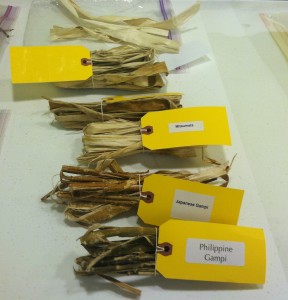On November 20-22 the Smithsonian Libraries hosted a three day workshop, “Understanding Asian Papers and their Applications in Paper Conservation,” given by Minah Song, a paper conservator at the Conservation Center for Art and Historic Artifacts (CCAHA) in Philadelphia. The workshop began with a lecture on the process of papermaking in China, Korea and Japan and then moved onto hands-on techniques including learning different lining techniques, toning or paper with fiber reactive dyes, parchment repair and the Korean art of Joomchi.
As part of the initial lecture we learned the differences between the paper making processes in China, Korea and Japan. We were also able to handle raw fiber samples and see slides of the different fibers under a microscope.

The hands on part of the workshop began with each participant creating a drying board out of Hexamount panels covered with Kozo paper and then coated with a thin layer of Lascaux 498 adhesive. The drying boards serve as the base for drying documents lined with Asian paper. These boards are a modern substitute for the traditional Karibari wooden frames used in Japanese paper conservation.

Day one ended with the class learning the art of Joomchi, a traditional Korean paper technique. In Joomchi a sheet of Mulberry paper is used as a base to build a design. Pieces of differently colored Mulberry paper are placed on top of the wet base paper then wet again and rolled into a ball that is thrown onto a hard surface. By repeatedly throwing the paper the fibers break down and bind to each other, in a similar manner to felting, creating a new piece of paper.

Two different lining techniques were taught in the workshop: a double-sided lining technique where the lined object is dried between felts and a single-sided lining technique where the object is dried on drying boards. A very thin paper is used in the double sided technique and a thicker paper was used for the single sided technique.


Remoistenable tissue, used for repairing paper that is sensitive to water, was our next project. Three different adhesives were used to coat a thin sheet (3.5gm) sheet of paper: gelatin, a methyl cellulose & wheat starch mix, and Lascaux 498. The sheet are dried and then when repairs are made the adhesive is reactivated with a mix of Ethanol and water (or straight Ethanol in the case of the Lascaux.)

Following the tissue creation we undertook the complexities of toning Asian paper using fiber reactive dyes. Many conservators are used to toning using acrylic or watercolor paints with the paint layer lying on the surface of the paper. The advantage of the fiber reactive dyes is that the pigment saturates the fibers, giving a more natural look to the toning and without the buildup or sheen of a paint layer. However, the dyes are trickier to mix and do not last so the process must be done quickly and precisely.


The last project was repairing parchment using a cold gelatin adhesive to adhere Mitsumata paper to the areas of loss. The cold gelatin was strained through a silk screen fabric and the caviar like adhesive was then worked with a brush into a paste. For small areas of loss a double sided application of Mitsumata was sufficient but for an area of loss at the edge multiple layers of paper were required.

The workshop was a terrific learning experience and the Book Conservation Lab is an ideal space for hosting workshops. Thanks to Vanessa Smith, Head of Preservation Services, for organizing the workshop and to our instructor Minah Song for her willingness to share her knowledge and her enthusiasm!

3 Comments
This must have been a really great day and a fascinating experience.
Thank you for sharing your experience. I’m a senior paper conservator working at Laboratório José de Figueiredo, the portuguese governmental organism for conservation and would like to reinforce a very brittle and oxidised western paper after treating it with a calcium phytate solution. I would like to use a gelatine remoistenable backing but do not know the percentage of gelatine. You speak of a cold gelatine of caviar like appearance for parchment. Can you help me with this remoistenable backing gelatine recipe? I’ve read of 0,5 to 1% for resizing but not for remoistenable tissues. Why do you use mitsumata fibres? We only have kozo fibres. What gramage should we use. A thin paper like tissue, and use more than one layer?
Hi this is Minah Song. I was an instructor in this workshop. If don’t mind, could you email me at minahsongstudio@gmail.com? I will reply to you with answers. Thanks!